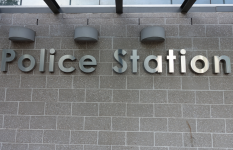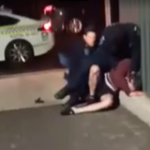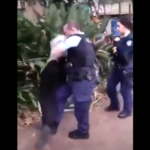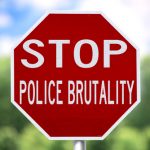The Continuing Issue of Police Brutality in Australia

The tragic death of 18-year-old African-American Michael Brown, who was shot dead by a white police officer in Ferguson, Missouri last year, thrust the issue of police brutality into the media spotlight.
Since the incident, a string of cases linked to police brutality and excessive force have emerged, with many ending in tragedy. Several of these involve African-American youth, or others from marginalised communities.
Just two days after Brown’s death, another black man, Ezell Ford, was shot dead by police in Los Angeles, with one shot being fired at close range. Ford reportedly had a history of mental health issues. And in November, Ohio police shot dead a 12-year-old child who was playing with a replica shotgun in a playground.
Closer to Home
But the United States is not the only country grappling with this problematic issue.
As reported in our previous blogs, there have been several instances of police brutality in Australia of late, with the number of fatal shootings by police increasing dramatically in recent years. But while American citizens have taken to the streets in thousands in protest against police brutality, it appears that Australians are far more reluctant to do so.
Police brutality is not just limited to fatal shootings. We recently wrote a blog about 16-year-old Aboriginal girl Melissa Dunn who was arrested by police for resisting arrest and hindering police. CCTV footage of the incident showed police officers brutally tackling the girl outside a McDonald’s restaurant in Sydney’s CBD, before her head hit the gutter and she was rendered unconscious.
A children’s court magistrate later found Melissa ‘not guilty’ of the charges and criticised police for using an ‘inordinate amount of force’ during her arrest. Melissa tragically ended her life just three days after her trial ended.
We also reported on the highly-publicised case of the young, slightly-built young man who was slammed to the ground during the Gay and Lesbian Mardi Gras by a heavily-built police officer. It seems that this brazen officer was undeterred by the presence of several members of the public, some of whom were filming the incident. The list goes on.
Such cases indicate that issues of police brutality and excessive force are a cause for concern in Australia, despite consecutive attempts to reform the law and redress these injustices.
The Current Law
Section 230 of the Law Enforcement (Powers and Responsibilities) Act 2002 states that the force used by police officers generally must be that which is ‘reasonably necessary to exercise the function.’
This is supported by section 231, which explicitly states that the use of force in making an arrest must be that which ‘is reasonably necessary to make the arrest or to prevent the escape of the person after arrest.’
Both sections are explicitly set out in the NSW Police Force Code of Practice for Custody, Rights, Investigation, Management and Evidence (CRIME).
Learning From Our Mistakes
LEPRA was borne out of the Wood Royal Commission into the New South Wales Police Force, which was held between 1995 and 1997 to investigate corruption within the Force.
An interim report noted that the number of police complaints had doubled since 1987, with many concerning matters such as excessive force and unreasonable arrest and detention.
LEPRA was intended to consolidate and clarify police powers with a view to reducing the abuse of power, assisting in training and safeguarding the rights of individuals when dealing with police. This was further supplemented by a number of other arrest provisions, including that an arresting officer must ‘suspect on reasonable grounds that it is prudent to do so.’
Official documents of the NSW Police Force state that police ‘should only use force that is reasonable, necessary, proportionate and appropriate to the circumstances,’ and significantly, that arrest should only be used as a last resort.
LEPRA clarified the ambit of force when making an arrest or exercising police functions, but in a 2009 submission, the Law Society of NSW noted that many officers still grappled with the legislation, and that further training is required so that police understand the meaning of ‘reasonably necessary’ and the extent of reasonable force.
The Law Society also noted that ‘many police officers do not appear to understand the need to consider alternatives to arrest, and to arrest only if none of those alternatives is appropriate.’
Yet despite these observations – and the fact that LEPRA was largely intended as a safeguard against abuses of police power – there has been a gradual expansion of those powers which has manifested in an erosion of individual rights and liberties.
Recent Changes to Police Powers
There was a police outcry in the years following the introduction of the LEPRA; and the media was all too keen to jump on the bandwagon and sensationalise the issue. News headlines despaired that the law favoured criminals, while police complained that the legislation was too difficult to apply. What came next was a gradual stripping back of individual rights and liberties.
In December 2013, amendments were made to section 99 of the Act, broadening the circumstances in which an arrest without a warrant can be made.
Notably, the amendments removed the requirement for arrest to be for the purpose of commencing proceedings, which many criminal lawyers argue removes the common law safeguard to arrest only as a last resort.
On top of this, the Act provides five new categories for arrest, some of which are relatively ambiguous. For instance, the new s 99(1)(b)(ix) states that an arrest can be made where it is justified due to the ‘nature and seriousness’ of the offence. The Act, however, provides no guidance as to the meanings of these terms.
Incidentally, mere months before these amendments were implemented, new right to silence laws were passed allowing a jury to draw a negative inference from a person’s decision to remain silent while being questioned by police in the presence of a lawyer. This effectively reversed the previous position, which was that no negative inference could be drawn.
The impact that these changes have on individual liberties is highly concerning, particularly when it comes to the treatment of vulnerable people such as indigenous Australians, those with mental health issues, and members of particular ethnic groups.
So, What’s the Solution?
Lawmakers are often confronted with the difficult task of balancing the protection of individual liberties against giving police the powers they need to carry out their duties. And, like any problem, there is no quick-fix solution in this case.
Perhaps a good start would be to reinstate the safeguards against arrest as a last resort that have been taken away, restore the right to silence so that lawyers are not effectively prevented from attending police stations to protect their clients’ interests, and introduce measures to ensure that police officers who engage in brutality are properly investigated by a body other than the police force itself.
Parts of the United States are indeed taking steps to address the issue of police brutality. The US city of Chicago, for instance, recently announced that it would be attempting to address its appalling history of police brutality by offering reparations to victims and requiring school children to learn about their city’s tainted past. Included in the package is a $5.5 million compensation fund for victims.
But while these efforts are certainly a step in the right direction, the onus is on Australian lawmakers to take action to prevent further injustices.






